| Top Ten NYC Architecture | top ten New York Bridges | |||||||||||||||
| For a more complete list, see Bridge | ||||||||||||||||
| 1 | Brooklyn Bridge | |||||||||||||||
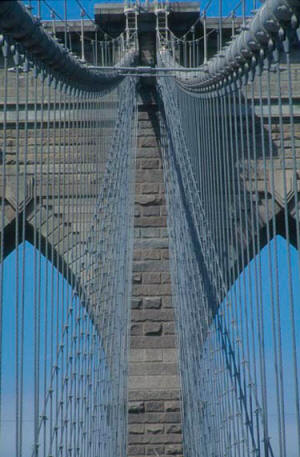 |
The Brooklyn Bridge, one of the oldest suspension bridges in the United States, stretches 5,989 feet (1825 m)[1] over the East River connecting the New York City boroughs of Manhattan and Brooklyn. On completion, it was the largest suspension bridge in the world and the first steel-wire suspension bridge. Originally referred to as the New York and Brooklyn Bridge, it was dubbed the Brooklyn Bridge in an 1867 letter to the editor of the Brooklyn Daily Eagle,[2] and formally so named by the city government in 1915. Since its opening, it has become an iconic part of the New York skyline. In 1964 it was designated a National Historic Landmark. |
|||||||||||||||
| 2 | Manhattan Bridge | |||||||||||||||
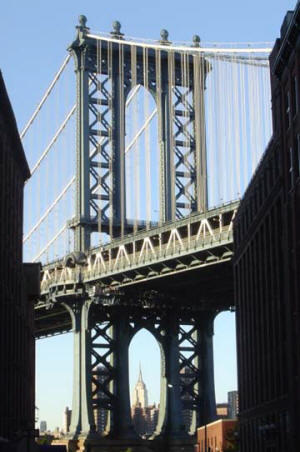 |
The Manhattan Bridge is a suspension bridge that crosses the East River in New York City, connecting Lower Manhattan (at Canal Street) with Brooklyn (at Flatbush Avenue Extension). It was the last of the three suspension bridges built across the lower East River, following the Brooklyn and the Williamsburg bridges. The bridge was opened to traffic on December 31, 1909 and was designed and built by Polish bridge engineer Ralph Modjeski with the deflection cables designed by Leon Moisseiff, who later designed the infamous Tacoma Narrows Bridge in 1940. It has 4 vehicle lanes on the upper level (split between two roadways), and 3 vehicle lanes, 4 subway tracks, a walkway and a bikeway on the lower level. The upper level, originally used for streetcars, has 2 lanes in each direction, and the lower level can be one-way in peak direction or have 2 lanes in one direction and the other in the opposite direction. It once carried New York State Route 27 and later was planned to carry Interstate 478. No tolls are charged for motor vehicles to use Manhattan Bridge. The original pedestrian walkway on the south side of the bridge was reopened after sixty years in June 2001. It was also used by bicycles until late summer 2004, when a dedicated bicycle path was opened on the north side of the bridge, and again in 2007 while the bike lane was used for truck access during repairs to the lower motor roadway. |
|||||||||||||||
| 3 | Williamsburg Bridge | |||||||||||||||
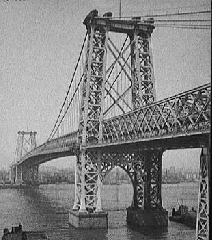 |
Construction on the bridge, the second to cross this river, began in 1896, with Leffert L. Buck as chief engineer, Henry Hornbostel as architect and Holton D. Robinson as assistant engineer, and the bridge opened on December 19, 1903 at a cost of $12,000,000. At the time it was constructed, the Williamsburg Bridge was the largest suspension bridge on Earth, and remained so until the Bear Mountain Bridge was completed in 1924. It is an unconventional structure, as suspension bridges go; though the main span hangs from cables in the usual manner, the side spans leading to the approaches are cantilevered, drawing no support from the cables above. The main span of the bridge is 1600 feet (488 m) long. The entire bridge is 7308 feet (2227 m) long between cable anchor terminals, and the deck is 118 feet (36 m) wide. The height at the center of the bridge is 135 feet (41 m) and each tower is 335 feet (102 m); these measurements taken from the river's surface at high water mark. |
|||||||||||||||
| 4 | George Washington Bridge | |||||||||||||||
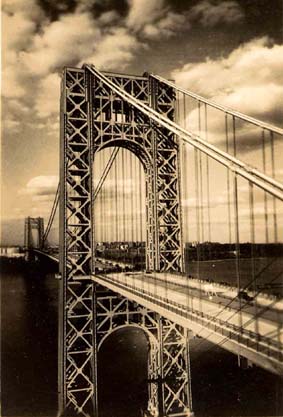 |
The George Washington Bridge (known informally as the GW Bridge[3], the GWB[4], the GW[5], or the George[6]) is a suspension bridge spanning the Hudson River, connecting the Washington Heights neighborhood in the borough of Manhattan in New York City to Fort Lee in New Jersey by means of Interstate 95, U.S. Route 1/9. U.S. Route 46, which is entirely in New Jersey, ends halfway across the bridge at the state border. The GW is considered one of the world's busiest bridges in terms of vehicle traffic;[7] In 2004, the bridge carried 108,404,000 vehicles, with current AADT estimates of nearly 300,000 vehicles daily. The GW span is the fourth largest suspension bridge in the United States. The bridge contains two levels, an upper level with four lanes in each direction and a lower level with three lanes in each direction, for a total of 14 lanes of travel. Additionally, the bridge houses a path on each side of the bridge for pedestrian traffic. The speed limit on the bridge is 45 mph (70 km/h), though heavy traffic is common and frequently makes it difficult to reach such speeds. |
|||||||||||||||
| 5 |
Hel |
|||||||||||||||
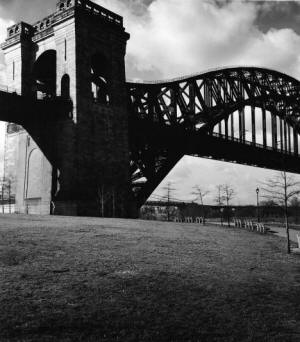 |
The Hell Gate Bridge (originally the New York Connecting Railroad Bridge or The East River Arch Bridge) is a 1,017-foot (310 m) steel arch railroad bridge between Astoria in the borough of Queens and Randalls and Wards Islands (which are now joined into one island and are politically part of Manhattan) in New York City, over a portion of the East River known as Hell Gate. The Bridge is used by Amtrak and by some CSX, Canadian Pacific, Providence & Worcester Railroad, and New York and Atlantic freight trains. The bridge and structure are owned by Amtrak, part of its Washington, D.C. to Boston electrified main line known as the Northeast Corridor. Metro-North Railroad trains may one day run on the bridge. The bridge is also part of the New York Connecting Railroad, a rail line that links New York City and Long Island to the North American mainland. The Hell Gate Bridge runs parallel to the Queens span of the Triborough Bridge, which connects Queens, the Bronx, and Manhattan, and drivers can see the length of the bridge just east of the roadway. The great arch bridge is the largest of three bridges, along with more than 17,000 feet (5.2 km) long of approach spans and viaducts, that form the Hell Gate complex. An inverted bowstring truss bridge with four 300-foot spans crosses the Little Hell Gate (now filled in); and a 350-foot fixed truss bridge crosses the Bronx Kills (also now filled in). |
|||||||||||||||
| 6 | Queensboro Bridge | |||||||||||||||
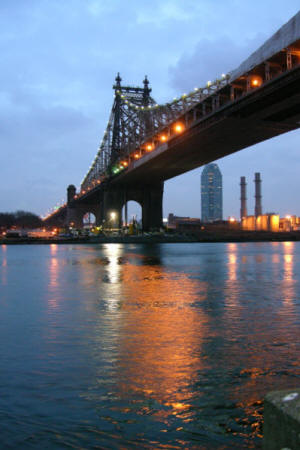 |
The Queensboro Bridge, also known as the 59th Street Bridge, is a cantilever bridge over the East River in New York City that was completed in 1909. It connects the neighborhood of Long Island City in the borough of Queens with Manhattan, passing over Roosevelt Island. It carries New York State Route 25 and once carried NY 24 and NY 25A as well. The Queensboro Bridge is the westernmost of the four East River spans that carry a route number: NY 25 terminates at the west (Manhattan) side of the bridge. It is commonly called the "59th Street Bridge" by New York City residents because its Manhattan end is located between 59th and 60th Streets. |
|||||||||||||||
| 7 | Triborough Bridge | |||||||||||||||
_small.jpg) |
The bridges span the Hell Gate (a tidal channel of the East River), Harlem River, and Bronx Kill. Construction had begun on Black Friday in 1929, and the Triborough project's outlook began to look bleak. Othmar Ammann's assistance was enlisted to help simplify the structure. Ammann had collapsed the original two-deck roadway into one, requiring lighter towers, and thus, lighter piers. These cost-saving revisions saved $10 million on the towers alone. Using New Deal money, the project was resurrected in the early 1930s by Robert Moses and the bridge was opened to traffic on July 11, 1936. Its cost was greater than that of the Hoover Dam. |
|||||||||||||||
| 8 | Verrazano Bridge | |||||||||||||||
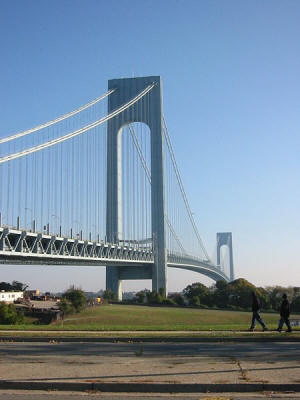 |
The Verrazano-Narrows Bridge is a double-decked suspension bridge that connects the boroughs of Staten Island and Brooklyn in New York City at the Narrows, the reach connecting the relatively protected upper bay with the larger lower bay. The bridge is named for Italian explorer Giovanni da Verrazzano, the first known European navigator to enter New York Harbor and the Hudson River, while crossing The Narrows. It has a center span of 4,260 feet (1,298 m) and was the largest suspension bridge in the world from the time of its completion in 1964 until 1981. It now has the seventh longest center span in the world but still is the largest suspension bridge in the United States. Its massive towers can be seen throughout a good part of the New York metropolitan area, including from spots in all five boroughs of New York City. |
|||||||||||||||
| 9 | Pine Bank Bridge | |||||||||||||||
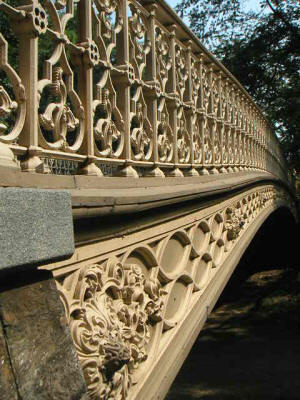 |
Located east of the West Drive at 62nd Street, stands the elegant Pine Bank Bridge, the most well known of all the bridges in Central Park. It is the only cast-iron bridge that still remains over the bridle path near the Heckscher Playground. Two other cast-iron bridges over the bridle path were unfortunately eliminated during its expansion in the 1930s. Nestled between two natural rock outcroppings it has two shaped concrete structures with four posts on both ends of the bridge. Take a stroll along the wood walkway to observe the beauty of its ornate cast-iron handrail, featuring intricate latticework in a Gothic influenced style. In 1984, the Pine Bank Bridge was restored by the Parks Department. |
|||||||||||||||
| 10 | Bow Bridge | |||||||||||||||
_small.jpg) |
|
|||||||||||||||